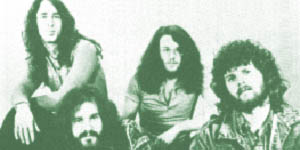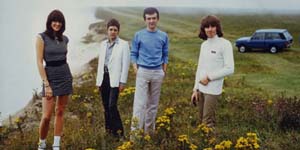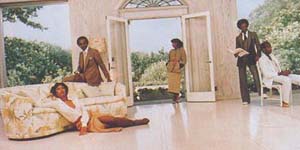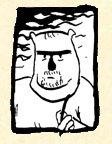The 100 Greatest Songs of the 1970s, Part VIII.

065. Looking Glass “Brandy (You’re a Fine Girl)”
(Elliot Lurie)
Looking Glass, 1972
Normally, I despise the too-common complaints about how popular music was so much better “back then,” usually meaning the golden age of 60s and 70s rock. Those whiners are the same as the people who were horrified by the rise of rock & roll in the 50s, and scandalized by jazz in the 20s. But occasionally, they can have a point. For example. “Brandy (You’re a Fine Girl)” is as perfectly dopey a slice of AM pop as the 70s ever provided, and could be used, along with selected hits of the Carpenters, America, and Loggins & Messina, to provide a kind of Lowest Common Denominator for 70s pop. Now compare it with the Lowest Common Denominator soft-pop of today, James Blunt or whatever. At least Looking Glass told a fucking story, however trite. Modern AM mush-pop is all grand generalities, all non-specific “I”s and “you”s, with a couple of common verbs and a universally-applicable adjective or two thrown in, with emoting in place of melody. “Brandy” is starting to look pretty good now, huh? Okay, so “it’s better than James Blunt” is nobody’s idea of high praise, but seriously, who can hate this song? It’s so damn cheerful, even though the narrative is about heartbreak and loss; it’s the horns, probably, that give it the extra something needed to break through into the eternal-pop pantheon. Where it is, in my book.
064. Throbbing Gristle “Hot on the Heels of Love”
(Throbbing Gristle)
20 Jazz-Funk Greats, 1979
The Gristle at their most floppy-eared bunny-hugging accessible, this song has been called everything from dark electro-funk to the first techno song. It’s actually got more in common with latter-day glitchtronica like Autechre than with anything out of Detroit in the mid-80s, but if you’re willing to stretch a point you can almost hear it. The punishing noise and splintered tape loops that made them the originators of industrial music have been left behind for the stark minimalist sound of sequencers thumping and bristling fragments of electronic melody, over which Cosey Fanni Tutti murmurs, sounding like a robot dominatrix, a lyric just as minimal: “Hot on the heels of love/I’m waiting for help from above.” But like John Lennon said of “I Want You (She’s So Heavy),” the lyrics are so spare because that’s all that needs to be said. You could call it the moment when the industrial side of post-punk, which had always been screamingly political rather than personal, first tipped over into the icy romanticism that, say, the Eurythmics would later exploit, but first that’s kind of an insult depending on what you think of the Eurythmics, and second the song doesn’t need any historical-fulcrum analysis in order to be a kickass song. If androids dream of electric sheep, this is the song those sheep waltz to when the dream edges into nightmare.
063. Rachel Sweet “Who Does Lisa Like?”
(Liam Sternberg)
Fool Around, 1978
Rachel Sweet was sixteen years old when she left Akron, Ohio for the greener pastures of post-industrial London and Stiff Records. A seasoned performer, brought up doing country covers on the county-fair circuit, she already had a huge, booming Patsy Cline voice and a facility with interpretation that many older performers could envy. The song’s writer, Liam Sternberg, came with her from Akron, a sort of burnt-out hippie manager-cum-svengali who, strangely enough, managed in his songwriting to nail a specific tone that could be American, English, or whatever — but it’s definitely teenager. Bored teenager, too (though Rachel sounds anything but), like the Ramones were supposed to be. The song is high-school lunchroom gossip, specific in its evocation of Americana — hanging around in the Firestone parking lot — but cheeky enough to appeal to British sensibilities too. And Nick Lowe matches that hat trick with one of his best productions: a nervous, twitchy rhythm, with several Rachels piled up on top of each other for those great plastic harmonies (and some help from labelmate and fellow Ohioan Lene Lovich on the high notes), and a fitful, spastic guitar played off a snarky, Clemonsy sax. By the end of the song, no one cares about that slut Lisa anyway; the cheerfully catty Rachel is the one all the boys want to hang with.
062. Chic “Le Freak”
(Bernard Edwards/Nile Rodgers)
C’est Chic, 1978
“Ahhh . . . freak out!” Although in the popular imagination disco is forever wedded to Saturday Night Fever, lapels big enough to shelter a starving African family, and bearded Gibbses, it was Chic who really brought the 4/4 glide out of the gay Harlem clubs and into the coke-snorting mainstream. And this is as good and smooth as disco ever got: orchestral swirl and soar, knotty bass workouts, black women singing smolderingly, and underneath it all the unstoppable high-hat/snare heartbeat. As in the other great stylish pop ménage of the 70s, the men did all the heavy lifting — songwriting, arrangement, production — and the girls looked hot and sang in breathless harmony. The lyrics don’t really matter — it’s disco, remember? — but this is the great self-reflexive song of the genre, literally inviting everyone down to Studio 54 where they could do “the Freak” (intentionally recalling fifteen-year-old dance-craze numbers lik the Twist or the Mashed Potato, but with a druggy gay subtext for those who knew), and even comparing the then-new disco scene to the swing-dance contests that used to be held at the Savoy Ballroom in the 40s, where the big bands of Duke Ellington, Benny Goodman, and Count Basie would bring the crystalline, impeccably-arranged funk all night long. Correspondingly, Birdland was CBGB’s.
061. Derek & the Dominos “Thorn Tree in the Garden”
(Bobby Whitlock)
Layla and Other Assorted Love Songs, 1970
I’m fully aware of the irony of choosing a track from Eric Clapton’s best album that doesn’t feature Clapton either singing or playing. But the Dominos really was a band, even if extremely short-lived. Bobby Whitlock, the songwriter and singer, is one of the central figures (along with drummer Jim Gordon and bassist Jim Keltner) in a loose aggregation of musicians, session players, stars and roadies who were responsible, among other things, for Joe Cocker’s Mad Dogs & Englishmen, most of Delaney & Bonnie’s output, Leon Russell’s Shelter People recordings, Derek & the Dominos’ work, and even Exile-era Rolling Stones. He was discovered by Delaney Bramlett in a Deep South juke joint, where his unfettered howl and aching falsetto, married to an almost punk-rock honky-tonk piano style, made him one of the famous Friends of Delaney & Bonnie. His solo material, captured on two 1972 albums that I never get tired of listening to, alternated between Stax-on-amphetamines hard rock and quiet, impossibly tender ballads like this one. Like many of the great singers of the 60s and early 70s, he made no distinction between country, blues, rock, and soul, and all of it is present in his boozy, heartachey voice. And then he breaks into that shivering falsetto, and Duane Allman’s guitar, almost whispering behind him, follows. It’s transcendent, is what it is, and it’s the best argument for rock & roll the guitar gods ever produced.
Next: 059-051. >>

2 comments:
http://www.youtube.com/watch?v=qGlsXl4gYtQ
I think ME AND MRS JONES is the song of a troubles 70s scene...
The best part of "Le Freak" is that it was written on the street after the band was denied entry to a club -- Studio 54, I think -- and the original lyrics were something to the effect of "Oh, f*ck you"...
Post a Comment